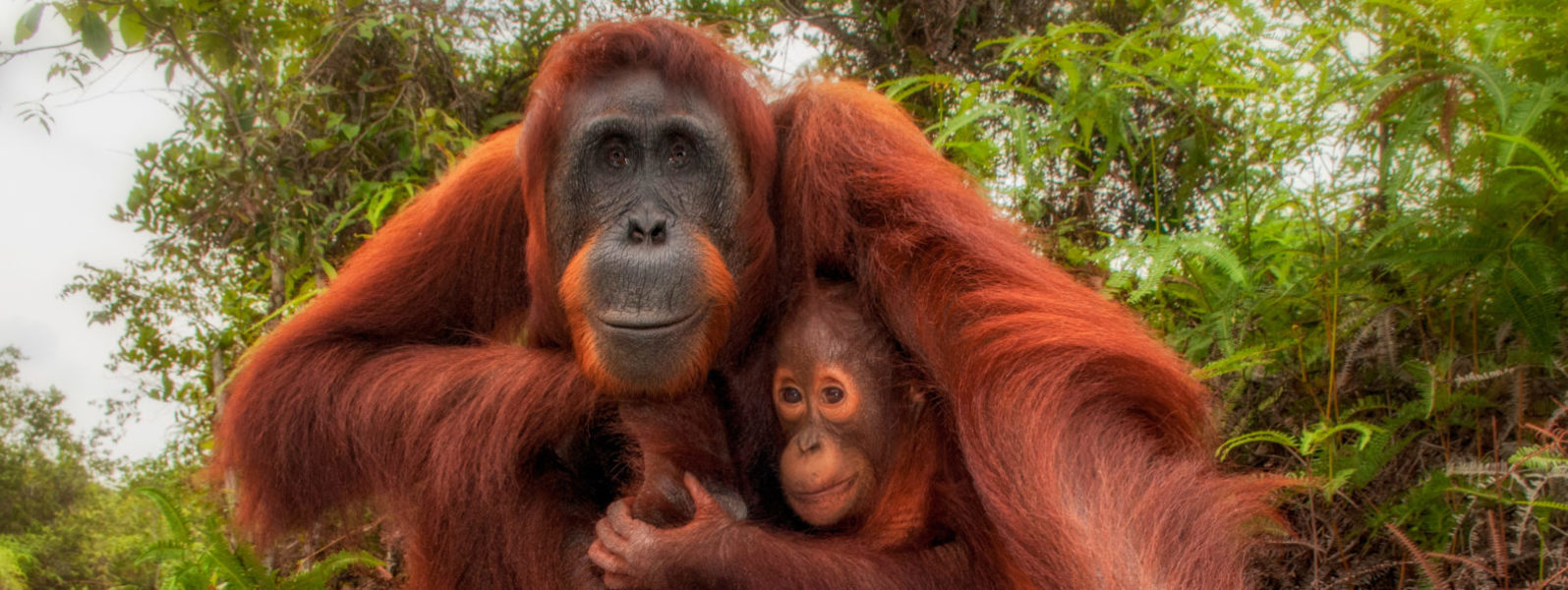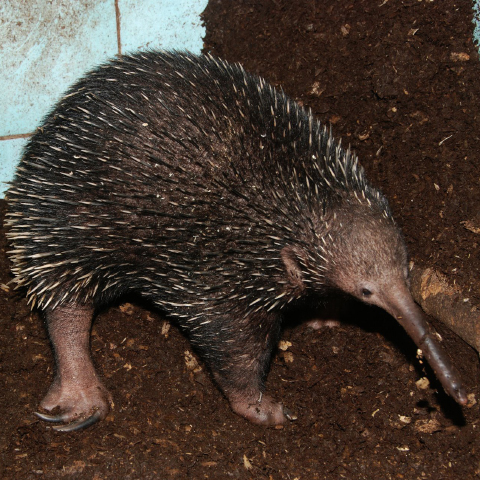Conservation Actions
The Bornean Orangutan is fully protected in Malaysia and Indonesia, and is listed on Appendix I of CITES. However, its forest habitat is not necessarily protected: about 20% of the current orangutan range in Sabah, and 80% in Kalimantan is not protected (Wich et al. 2012). Innovative mechanisms to ensure the long-term survival of Bornean Orangutans outside protected forests are urgently needed.
The future of Bornean Orangutans will very much depend on the long-term security of large, strictly-protected forests where illegal logging and hunting will be efficiently controlled and the orangutan populations large enough to cope with catastrophic events such as fires and disease outbreaks (Meijaard et al. 2011). These forests need to contain the ecological gradients that will provide the key resources to sustain orangutans through climate and other gradual environmental changes (Gregory et al. 2012). In the larger landscape, scientifically-based, regional land-use planning is needed to delineate zones of interaction around protected forests and their surroundings, encompassing hydrological, ecological and socio-economic interactions. Ideally, the core protected areas will remain connected to other areas of forest that could be used sustainably for (commercial) timber extraction. The design of such living landscapes must be approached across the whole landscape rather than at the site level.
Location Information
The Bornean Orangutan is endemic to the island of Borneo where it is present in both the Malaysian states of Sabah and Sarawak, as well as in four of the five Indonesian Provinces of Kalimantan: North, East, Central and West Kalimantan. The distribution of Bornean Orangutans is highly patchy throughout the island; they are apparently absent or uncommon in the southeast, the forests between the Rejang River in central Sarawak, and the Padas River in western Sabah (including the Sultanate of Brunei). The Bornean Orangutan occurs preferentially in lowland forests below 500 m asl, but some individuals can also be found in highland habitats, for example, up to 1,500 m asl in Kinabalu National Park. Large rivers are natural barriers that are impassable to these animals and limit their dispersal (Goossens et al. 2005).Geographic Range
Extant
Indonesia, Malaysia
Population Information
Climatic change and human pressure have resulted in significant reductions in the range and numbers of Bornean Orangutans during the recent historic past (Goossens et al. 2006, Meijaard et al. 2010).
The total number of orangutans in Borneo is not precisely known, except for Sabah, where comprehensive aerial surveys in the early 2000s provided an estimate of 11,000 individuals for the entire State (Ancrenaz et al. 2005). The most recent (2004) estimate for the species is that c. 55,000 Bornean Orangutans inhabit 82,000 km² of forest (Wich et al. 2008). However, using modelling and the latest field data available for Borneo, a revised map of their current distribution gives a larger range estimate of 155,000 km², or 21% of Borneo’s landmass (Wich et al. 2012). If the mean average orangutan density recorded in 2004 (0.67 individuals/km²) is applied to the updated geographic range, then the total population estimate would be 104,700 individuals. This represents a decline from an estimated 288,500 individuals in 1973 and is projected to decline further to 47,000 individuals by 2025.
Compounding loss of habitat, recent interview surveys in Kalimantan have concluded that 2,000–3,000 orangutans were killed every year in Indonesian Borneo during the past four decades alone (Meijaard et al. 2011). This would represent a loss of 44,170–66,570 individuals (Davis et al. 2013), or more than 50% of the original population in just 40 years. Such a rate of killings is unsustainable (Marshall et al. 2009) and many populations will be reduced or become extinct in the next 50 years (Abram et al. 2015).
Threats
Major threats include:- Habitat loss. Between 2000 and 2010, the mean annual rate of deforestation for Borneo was 3,234 km² per year (Gaveau et al. 2014). Assuming a similar deforestation rate in the future, 32,000 km² of forest could be lost by 2020; 129,000 km² by 2050 and 226,000 km² by 2080 (Wich et al. 2015). In the early 2010s, only 22% of the current Bornean Orangutan distribution was located in protected areas (Wich et al. 2012). Approximately a third of the entire Bornean Orangutan range was in commercial forest reserves exploited for timber, and about 45% was in forest areas earmarked for conversion to agriculture or other land uses. A business-as-usual scenario, whereby non-protected forests would be converted along the lines of current development plans, will result in the loss of more than half of the current orangutan range on the island of Borneo in the next 50 years or so.
- Illegal hunting. Illegal killing of Bornean Orangutans is a major cause of their decline. Recent interview surveys conducted in Kalimantan revealed that several thousand individuals are killed every year for meat consumption, as a way to mitigate conflict, or for other reasons (Davis et al. 2013). Overall Bornean Orangutan mortality rates in Kalimantan seem to significantly exceed the maximum rates that populations of this slow-breeding species can sustain (Marshall et al. 2009, Meijaard et al. 2011). If hunting does not stop, all populations that are hunted will decline, irrespective of what happens to their habitat. These findings confirm that habitat protection alone will not ensure the survival of orangutans in Indonesian Borneo, and that effective reduction of orangutan killings is urgently needed.
- Fires. Fires occur in Borneo on a yearly basis and are responsible for significant forest loss with dramatic results for certain orangutan populations. For example, 90% of Kutai National Park was lost to massive fires in 1983 and 1998 and its Bornean Orangutan population was reduced from an estimated 4,000 individuals in the 1970s to a mere 600 (Rijksen and Meijaard 1999); over 4,000 km² of peatland forest in southern Kalimantan was burnt to ashes in six months of 1997–1998, resulting in an estimated loss of 8,000 orangutans. In 2015, more than 20,000 km² of forest were lost to fires, which resulted in hundreds (or more) of additional orangutan deaths.
- Habitat fragmentation. With the current scale of habitat exploitation and forest conversion to other types of land uses in Borneo, only a small percentage of current orangutan habitat will remain undisturbed by infrastructure development by 2030 (Gaveau et al. 2013). Several orangutan PHVAs have shown that Bornean Orangutan populations of fewer than 50 individuals are not viable in the long term (Marshall et al. 2009), and that many small populations will go extinct unless they are actively managed (Bruford et al. 2010).
- Lack of awareness. A recent study suggested that 27% of the people in Kalimantan did not know that orangutans are protected by law (Meijaard et al. 2011). Campaigns to effectively inform the public and encourage rural people to support the principles of environmental conservation and be actively responsible for the management of their resources are therefore a crucial requirement for successful orangutan conservation.
- Climate change. Spatial models point to the possibility that a large amount of current orangutan habitat will become unsuitable because of changes in climate (Struebig et al. 2015). Across all climate and land-cover change projections assessed in a recent analysis, models predicted that 49,000–83,000 km² of orangutan habitat will remain by 2080, reflecting a loss of 69–81% since 2010. This projection represents a three to five-fold greater decline in habitat than that predicted by deforestation projections alone. A major reduction in the extent of suitable orangutan habitat can be expected. However, core strongholds of suitable orangutan habitat are predicted to remain to the west, east and northeast of the island where populations of P. p. wurmbii and P. p. morio are found.
Partners
IUCN Red List Account Link
Please click here to see the species' IUCN Red List Account page.Photo Credits
Thumb nail: Geoffrey Oddie
Featured image: Simone Sbaraglia










